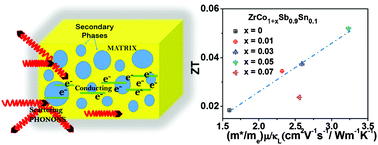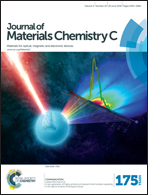A synergistic combination of atomic scale structural engineering and panoscopic approach in p-type ZrCoSb-based half-Heusler thermoelectric materials for achieving high ZT†
Abstract
Developing thermoelectric materials with high ZT revolves around various processing techniques, such as doping, substitution chemistry, and band structure engineering near the Fermi level due to embedded nanoscale precipitates and/or quantum dots, and more recently introduced compositionally alloyed hierarchically organized microstructures. In this work, we have extended atomic scale structural engineering combined with an overarching panoscopic approach enabling the development of hierarchically organized microstructures at multiple length scales to Hf-free p-type half-Heusler thermoelectric materials for the first time. A series of compositions ZrCo1+xSb0.9Sn0.1 have been synthesized employing a fast processing technique of arc melting followed by conventional hot pressing revealing composites of half-Heusler (HH) and full-Heusler (FH) at multiple length scales. Such microstructural modifications at various length scales lead to controlled tuning of the hole density, effective mass and band engineering. Interestingly, a simultaneous large enhancement of the power factor (72%>) and a reduction in thermal conductivity (30%>) of the resulting ZrCo1+xSb0.9Sn0.1 composites were observed. The enhancement in the power factor was primarily due to the increased Seebeck coefficient which resulted from a reduction in the effective hole carrier density via low energy electron filtering coupled with an increase in the hole carrier's effective mass (m*) due to band off-set minimization. The reduction in thermal conductivity can be ascribed to the enhanced phonon scattering by different frequency heat-carrying phonons due to various grain sizes at multiple length scales, such unique specific design strategies of materials described here result in superior thermoelectric properties which have been compared with several state-of-the-art p-type half Heusler materials. The Bergman–Fel model is used to calculate the effective thermoelectric parameters of these composites for comparing the experimental results.


 Please wait while we load your content...
Please wait while we load your content...